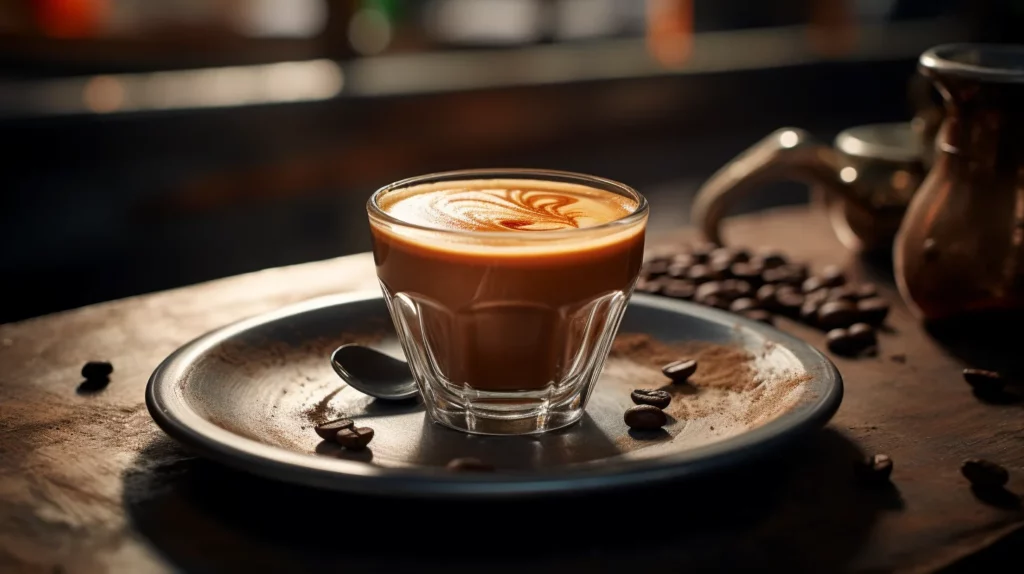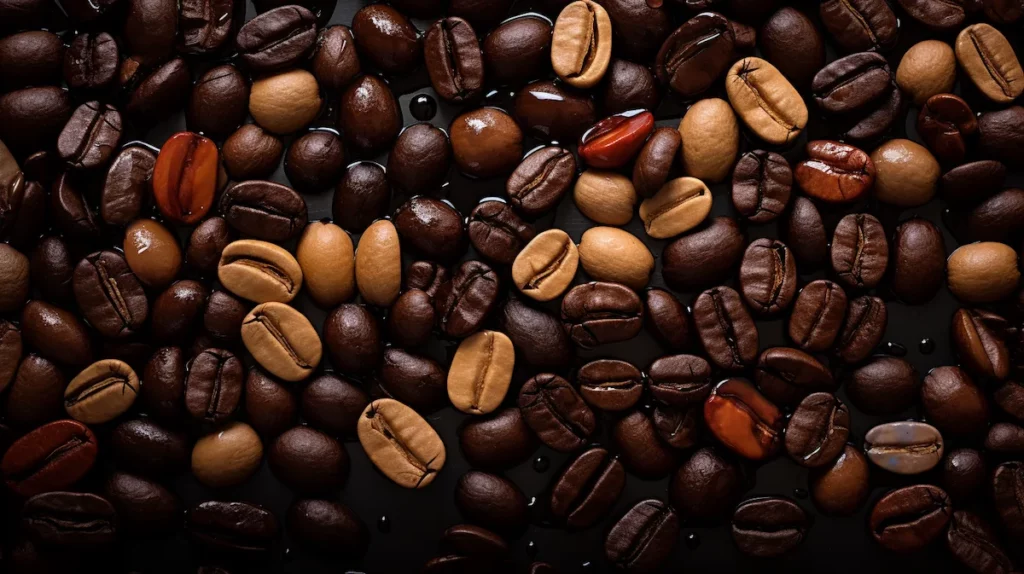Have you ever sipped on a cup of espresso in a coffee shop and wondered what the creamy foam on top is? That’s the ‘crema’, a byproduct of the coffee extraction process that adds depth and flavor to your everyday brew.
In this article, we’ll dig deeper into this fascinating layer that sites atop a shot of espresso. We’ll look at its formation and composition, and explain why it’s such an important part of the perfect espresso.
Key Takeaways
- Espresso crema is the rich, golden brown foam that forms on top of a freshly brewed espresso shot and is a byproduct of the extraction process.
- It is composed of coffee oils, carbon dioxide, and water vapor, which give it its smooth texture, intense flavor profiles, and creamy appearance.
- Coffee crema enhances the overall espresso experience by adding depth to the flavor profile, providing a delightful creaminess to each sip and by adding visual appeal to the drink.
What is Coffee Crema?
Crema forms during the espresso extraction process, as a direct result of the high-pressure brewing. The intense force exerted by an espresso machine pushes hot water through finely ground coffee beans, causing the release and emulsification of coffee oils.
These oils rise to the surface, resulting in a rich, caramel-colored foam known as crema. Tiny bubbles of air get trapped within this matrix of liquified coffee solids and coffee bean oils that are under suspension, giving crema its characteristic creamy texture and appearance.
It’s not just about looks though – these beautiful layers also carry the aromatic compounds that are essential for the flavors in coffee.
Composition of crema
Crema is composed of several key elements, including coffee oils, carbon dioxide, and water vapor. The oils are responsible for giving the crema its texture and intense flavor profiles. They also play a crucial role in emulsifying the aromatics within the espresso.
The carbon dioxide creates tiny bubbles in the ideal crema, adding to its creamy appearance. Lastly, water vapor adds moisture to the crema, which provides its delicate consistency. These elements come together to create an enticing layer that enhances your espresso experience by providing depth of flavor and visually appealing aesthetics.
Get any of these elements wrong and you may have less crema on top of your espresso.
Importance of Coffee Crema in the Perfect Espresso
The flavor and aroma of the crema play a significant role in enhancing the overall experience of enjoying an espresso. When you take a sip, the velvety texture and rich flavor of the crema instantly hits your taste buds.
It imparts a delightful creaminess to each sip while also adding depth to the coffee’s taste profile. Additionally, the tasting notes released by the crema fill your senses with enticing scents that further elevate your coffee-drinking experience.
The perfect combination of flavors in the crema is what makes every espresso shot truly exceptional.
Texture and appearance
The texture and appearance of coffee may play a significant role in the overall espresso experience. When you prepare your favorite cup of espresso, that rich layer of foam on top, the bubbly crema, adds a delightful smoothness to the drink.
The luxurious velvety texture gives your taste buds an indulgent sensory experience while sipping on your coffee. Additionally, the rich caramel color and thickness add visual appeal to your espresso shot, making it even more inviting.
Achieving a perfect balance between texture and appearance is key for baristas and coffee lovers alike. It indicates the quality of extraction and brewing techniques used to achieve that delicious cup of java we all crave.
Factors Affecting Coffee Crema And Avoiding Bad Crema
The type of coffee beans, the roasting level, and the brewing parameters all play a role in determining the quality of coffee crema.
Type of coffee beans
Coffee beans play a crucial role in the formation of crema. The type of beans used can greatly impact the flavor and overall quality of the drink. Different varieties such as Arabica and Robusta have distinct characteristics that contribute to the final result.
Arabica beans are known for their complex flavors, while Robusta coffee beans have a higher caffeine content and produce a thicker crema. It’s important to choose high-quality coffee beans that suit your preferences when aiming for a luscious and flavorful crema in your espresso shot.
Roasting level
The roasting level of coffee beans has a significant impact on the formation and composition of espresso crema. When it comes to espresso, the roast level plays a crucial role in determining the overall flavor.
Different roast levels can also produce varying characteristics in crema, offering a wide range of taste experiences.
When coffee is roasted, the beans undergo chemical changes that affect their physical properties and flavors. Lighter roasts result in brighter and fruitier flavors with lighter body in which a less pronounced crema is formed. These tend to be more acidic.
On the other hand, darker roasts yield richer, bolder flavors with more intense crema.
It’s important to choose a roast level that suits your personal preference and desired cup profile. Whether you enjoy a light-bodied espresso with bright acidity or prefer a full-bodied cup with bold flavors, understanding how different roast levels influence the crema can help you fine-tune your brewing technique for an optimal espresso.
Brewing parameters
To achieve the perfect coffee crema in your espresso, it’s important to consider the brewing parameters. These parameters refer to factors such as the grind size, water temperature, and extraction time.
The grind size affects how quickly or slowly water passes through the coffee grounds, while the water temperature impacts the overall flavor extraction. Additionally, controlling the extraction time ensures that you’re not under or over-extracting your coffee.
By experimenting with these brewing parameters, you can fine-tune your espresso shot to achieve a rich and creamy crema that enhances both the flavor and aroma of your coffee. So next time you’re preparing an espresso, pay attention to these brewing parameters for a delightful cup of java!
Espresso Coffee With Perfect Crema Really Makes A Difference
Next type you make (or order) an espresso, make sure to check out the caramel-colored foam that sits atop the coffee.
This delicate layer not only adds visual appeal but also enhances the flavor and texture, making it an essential component in a good shot of espresso.
How do you like your crema? Do you miss it on filter coffee? Let us know in the comments below.
FAQs
What is crema?
Crema refers to the creamy, light tan layer of foam that forms on top of a properly brewed espresso shot. It is created when hot water forces oils from the coffee grounds to emulsify, resulting in a rich and flavorful foam.
What is coffee crema made of?
Coffee crema is made up of a combination of carbon dioxide and coffee oils. When hot water passes through finely ground coffee beans, the carbon dioxide is released, creating pressure to push the oils to the surface. This infusion of oils and carbon dioxide forms the creamy layer of foam commonly found on top of a well-brewed espresso shot.
Why is crema important in coffee?
Crema is important in coffee because it adds complexity and enhances the overall taste and texture of the drink. It is a golden layer of froth that forms on top of espresso, trapping and intensifying the aromatic compounds. Crema also helps to regulate the release of carbon dioxide, preserving the coffee’s freshness and preventing it from becoming bitter.
What does coffee crema taste like?
Coffee crema has a smooth and velvety texture with a rich and slightly sweet flavor. It tastes like a combination of caramel, chocolate, and nuts, with hints of bitterness. The crema adds a creamy and luxurious element to the coffee, enhancing its overall taste and aroma.
What is crema vs foam coffee?
Crema and foam are two different elements found in coffee. Crema refers to the frothy layer on top of an espresso shot, which is created by the emulsification of oils in the coffee. On the other hand, foam is the result of milk being steamed and aerated, often used in drinks like cappuccinos and lattes. Both play a significant role in enhancing the flavor and texture of coffee beverages.
Why does my coffee not have good crema?
There could be several reasons why your coffee does not have good crema. One possibility is that your coffee beans are stale or not freshly roasted. Another reason could be that your espresso machine is not properly calibrated or maintained. Additionally, using too fine or too coarse grind size can affect the quality of the crema.
Is coffee crema sour?
Coffee crema is not typically sour. The crema is the layer of foam that forms on top of espresso when it is brewed. It is usually described as having a rich and smooth texture, with a slight sweetness. However, the taste of coffee can vary depending on the beans and the brewing method used.

Coffee expert and industry insider, I’ve dedicated years to mastering the art and science of coffee making. From scrutinizing particle fineness to evaluating burr shapes, I delve into the minutiae that elevate coffee from good to exceptional. Whether it’s a complex pour-over or a robust espresso, my insights cater to those who don’t just drink coffee, but experience it.




